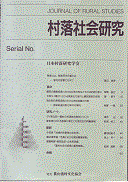2 巻, 2 号
選択された号の論文の9件中1~9を表示しています
- |<
- <
- 1
- >
- >|
論文
-
1996 年 2 巻 2 号 p. 1-7
発行日: 1996年
公開日: 2013/03/12
PDF形式でダウンロード (5963K) -
1996 年 2 巻 2 号 p. 8-18
発行日: 1996年
公開日: 2013/03/12
PDF形式でダウンロード (9061K) -
1996 年 2 巻 2 号 p. 19-30
発行日: 1996年
公開日: 2013/03/12
PDF形式でダウンロード (10155K)
研究ノート
-
1996 年 2 巻 2 号 p. 31-42
発行日: 1996年
公開日: 2013/03/12
PDF形式でダウンロード (9802K) -
1996 年 2 巻 2 号 p. 43-53
発行日: 1996年
公開日: 2013/03/12
PDF形式でダウンロード (8720K)
書評
-
1996 年 2 巻 2 号 p. 54-55
発行日: 1996年
公開日: 2013/03/12
PDF形式でダウンロード (1758K) -
1996 年 2 巻 2 号 p. 56-57
発行日: 1996年
公開日: 2013/03/12
PDF形式でダウンロード (1720K) -
1996 年 2 巻 2 号 p. 58-59
発行日: 1996年
公開日: 2013/03/12
PDF形式でダウンロード (1843K)
エラータ
-
1996 年 2 巻 2 号 p. 62
発行日: 1996年
公開日: 2013/03/20
PDF形式でダウンロード (491K)
- |<
- <
- 1
- >
- >|
